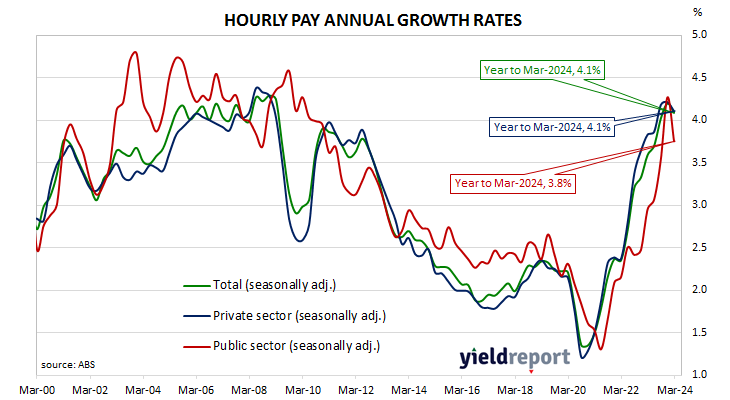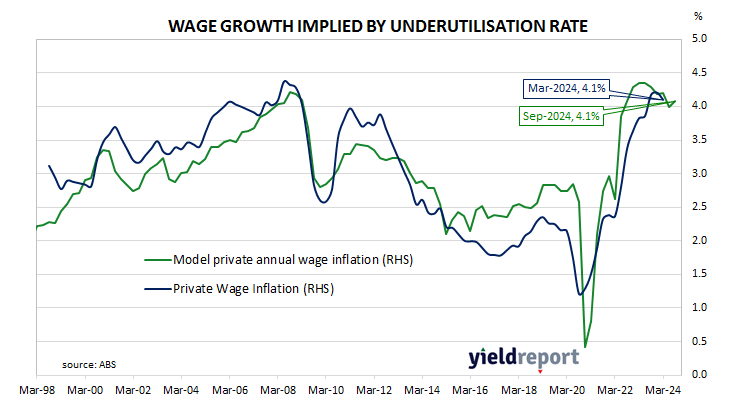Summary: March quarter WPI up 0.8%, slightly below expectations; annual growth rate slows to 4.1%; Westpac: first moderation in wage inflation since March 2022; ACGB yields decline modestly; rate-cut expectations firm slightly; ANZ: biggest surprise was smaller-than-expected rise from EBAs; private sector wages up 4.1% over year, public sector up 3.8%; March underutilisation rate suggests stable private wage growth in short-term.
After unemployment increased and wage growth slowed during the GFC, a resources investment boom prompted a temporary recovery back to nearly 4% per annum. However, from mid-2013 through to the September quarter of 2016, the pace of wage increases slowed, until mid-2017 when it began to slowly creep upwards. After remaining fairly stable at around 2.2% per annum from September 2018 to March 2020, the growth rate slowed significantly in the June and September quarters of 2020. Growth rates then accelerated over the next three years.
According to the latest Wage Price Index (WPI) figures published by the Australian Bureau of Statistics (ABS), hourly wages excluding bonuses grew by 0.8% in the March quarter. The result was slightly below expectations of a 0.9% increase and lower than the December quarter’s 1.0% rise. On an annual basis, the growth rate ticked down from 4.2% to 4.1%.
“This marks the first moderation in wage inflation since March 2022 as the public sector cycles out of last year’s above-average gains,” said Westpac economist Ryan Wells.
Domestic Treasury bond yields declined modestly on the day. By the close of business, the 3-year ACGB yield had returned to its starting point at 3.95%, the 10-year yield had slipped 1bp to 4.33% while the 20-year yield finished 2bps lower at 4.63%.
In the cash futures market, expectations regarding rate cuts in the next twelve months firmed slightly. At the end of the day, contracts implied the cash rate would remain close to the current rate for the next few months and average 4.315% through June and 4.34% in August. November contracts implied 4.33% and February 2025 contracts implied 4.27%. However, May 2025 contracts implied 4.16%, 16bps less than the current cash rate.
“The biggest surprise for us in today’s data was the smaller than expected contribution to overall wages growth from enterprise bargaining agreements (EBA),” said ANZ senior economist Catherine Birch. “This likely reflected public sector dynamics, with public sector wage growth decelerating to 0.5% in Q1 from 1.4% in the previous quarter. The ABS noted the implementation of new public sector EBAs and the changes to wage caps last year saw scheduled pay rises in Q3 and Q4 2023 rather than Q1 2024.”
Wages in the private and public sectors grew by 0.9% and 0.5% respectively in the quarter. Over the past 12 months, wages in the private sector increased by 4.1% while public sector wages increased by 3.8%. Annual wage growth in the two sectors had been at 4.2% and 4.3% respectively in the December quarter.
The “underutilisation rate” is simply the sum of the unemployment and underemployment rates as per ABS monthly statistics. It has a good correlation with private wage growth two quarters in the future and thus it is useful as a leading indicator. However, differences can open up from time to time. March’s underutilisation rate suggests private wage growth will stabilise in the short-term.
Each quarter the ABS surveys around 3,000 private and public enterprises regarding a sample of jobs in each workplace to measure changes in the price of labour across 18,000 jobs. The results are used to construct the Wage Price Index in a manner similar to the construction of the Consumer Price Index (CPI). Changes in the WPI over time provide a measure of changes in wages and salaries, independently of the type or quantity of work.



